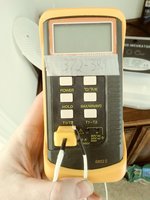I posted this in the Intro forums, but I figure that it would probably get a bit more traction in a forum specifically geared toward incubation.
Long story short, about a week ago, during a brief spell of cold and snow in western MI, I found an egg floating in a nearby pond/lagoon. It was quite large and I figured it was from a Canadian Goose or a Mute Swan, both of which reside in the area. After some research, I am still unsure of which fowl the egg belongs to, but I did find information about the viability of eggs after being exposed to cold weather. I decided I would try my hand at incubation and hatching.
I went the styrofoam incubator route as purpose designed incubators tend to be very expensive, as I found out. The current setup is a single 25W standard incandescent bulb controlled by a water heater lower thermostat, a small 4" fan, and a tupperware bowl with a sponge. The egg is in another tupperware bowl and rests on a very comfortable bed of microfiber towels. It is being flipped 3-4 times a day.
For temperature measurement I am using two "instant read" analog food thermometers. They are able to be calibrated, which is why I chose them. Humidity may as well not even be considered measured at this point because the digital temp/humidity gauge I have is a cheap piece of crap.
It is currently day 6 of incubation, and I candled the egg yesterday. It's definitely fertile and appears to be just a day or two before the embryo/membrane begin to form.
After seeing how large cygnets and goslings actually are when they hatch, I am led to believe that the styrofoam cooler is going to be of inadequate size. Provided that embryonic development continues to follow a normal trajectory, my plan is to get a larger plastic cooler and outfit it with more advanced means of temperature and humidity regulation. I am an automation technician by trade and am considering industrial style controls to maintain an ideal environment.
I do have a few questions for those with advanced technical knowledge of commercial incubators and their control systems.
1. What is the means of temperature regulation? I am looking at PID temperature controllers in order to avoid overshooting, or undershooting the set temp. The issue that I'm seeing is that even with class-A RTD sensors, the temperature controller accuracy is typically +/- 1° C/F or as much as 0.5% of full sensor range which equals out to ~3.5° on some units. Everything I am seeing tells me that I want to stay within a +/- 0.5° range of the set temperature, however I have not found anything that would allow for that level of accuracy without spending thousands of dollars. I have a hard time believing the typical $300-400 incubators are maintaining temps within that window.
2. I understand it is not as essential to be completely accurate with humidity control, but none the less I would like to set up an automated system to maintain the humidity. The main reason for this is during the lockdown, I work 12 hour shifts and will need extended protection against excessive drying. The issue I am seeing here is that all of the humidity sensors I can find seem to be in the $200+ range which I am certainly not paying, at that rate I would buy an actual incubator. The exception to this is the dual temp/humidity sensor from Auber, which uses a 4 pin screw type connection. I do not know what signal it outputs, or how it is wired so I don't know if it is able to be used as input to a process controller.
Any input would be appreciated, I will also move this to a different section of the forum if the questions here would be better answered somewhere else!

